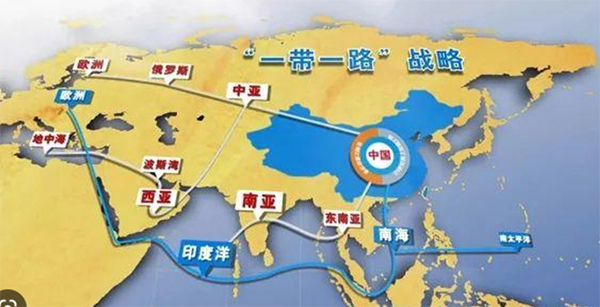Investment data shows that the Chinese Communist Party&9;s Belt and Road Initiative (BRI) has shifted from large-scale infrastructure projects to less capital-intensive sectors such as IT and biotechnology.
[People News] November 4, 2025 — As China’s economy struggles amid a real estate collapse and global trade frictions, several grand projects personally launched and promoted by Xi Jinping are again drawing controversy. From the ghostly emptiness of the Xiong’an New Area to the debt wave of the Belt and Road Initiative, these “national endeavors” began with high-profile fanfare but frequently ended in “boisterous starts and chaotic finishes.”
Official propaganda keeps stressing the “great changes unseen in a century,” yet in the 2025 “15th Five-Year Plan,” many of these projects have either been toned down or face international backlash.
This article takes a nonpartisan look at these flagship initiatives of the Xi era—examining their original visions, real-world dilemmas, and systemic causes—not to simply criticize, but to reveal the growing pains inherent in a power-driven development model.
From Ambition to Disillusionment: The Gap Between Vision and Reality
Since coming to power, Xi Jinping has emphasized “top-level design” and “mobilizing national strength to achieve great undertakings.” He has launched a series of national-level megaprojects meant to embody the “Chinese Dream” of national rejuvenation and global influence.
These initiatives often bore Xi’s personal imprint—such as the Xiong’an New Area, called a “millennium plan,” and the Belt and Road Initiative, dubbed the “revival of the Silk Road.” Yet by 2025, data show that while investment has exceeded the trillion-yuan mark, the results are rising debt, growing isolation, and worsening inefficiency.
On Platform X, the phrase “Xi Jinping’s vanity projects left unfinished” has become popular, with netizens joking that “everything he touches ends up unfinished.” Below is an overview of the most typical cases—Xiong’an being only one of them.
1. Xiong’an New Area: The “Millennium Plan” Becomes the No. 1 Ghost City
Personally designed by Xi in 2017, it was meant to relieve Beijing’s non-capital functions and accommodate a population of 5 million, with investments exceeding 1.5 trillion yuan.
Although Asia’s largest high-speed railway station was built and some ecological restoration achieved, by 2025 the Rongdong district’s vacancy rate exceeded 70 percent, and its population was less than one-tenth of the target.
Residents complain about the lack of supporting infrastructure and say life there is “too boring.”
One X user quipped: “You spent a trillion to build an empty city—who’s going to live there?”
Lesson: Detached from Hebei’s agricultural foundation, high-standard planning has proven impossible to implement.
2. Belt and Road Initiative: The “Silk Road Dream” Turns into a One-Way Trap
Proposed by Xi in 2013, it covers 140 countries with investments exceeding 1 trillion USD, funding ports and railways like Sri Lanka’s Hambantota Port.
By 2025, 75 of the world’s poorest countries owe China $35 billion, triggering a global “debt wave.”
Over 60 percent of projects are losing money, drawing accusations of “debt-trap diplomacy.”
Italy and other nations have withdrawn.
A trending post mocked it as “from Silk Road dream to unfinished road.”
3. Asian Infrastructure Investment Bank (AIIB): From ‘All Nations Come to Join’ to ‘All Nations Come to Mock’
Launched by Xi in 2015 with over 100 member states to finance infrastructure.
By 2025, criticism focuses on excessive Chinese political influence: Canada froze cooperation, and former employees revealed a “toxic culture” and espionage risks.
Project approvals are “overly simplified,” environmental standards lax, and the bank functions more as a geopolitical tool than a neutral financial institution.
4. Global Confucius Institutes: From Cultural Outreach to Global Shutdown
Accelerated under Xi since 2004, with the goal of 1,000 institutes promoting Chinese language.
By 2025, 104 in the U.S. have closed, followed by many in Australia, amid accusations of propaganda and academic interference.
Over half worldwide have shut down, labeled “Trojan horses.”
5. Thousand Talents Program: A Talent Dream Turned Espionage Nightmare
Launched 2008 and strengthened under Xi to attract overseas Chinese experts.
By 2025, U.S. sanctions intensified after repeated scandals: researchers concealed participation and transferred data to China.
It became a “counter-espionage target,” severely harming U.S.–China academic exchange.
6. Domestic Chip Production: ‘Overtaking on a Bend’ Meets the Sanctions Wall
Central to Made in China 2025, with 2 trillion yuan investment and firms like Huawei leading.
But by 2025, self-sufficiency is only 20 percent; 7 nm technology remains restricted.
U.S.–China export bans have delayed Huawei’s AI chips.
Though some progress exists, overall development is “stagnant.”
7. Domestic Jetliner (C919): Bragging Ends in Delivery Disappointment
Started 2008, repeatedly inspected by Xi, aimed to rival Boeing and Airbus.
By 2025, deliveries are severely delayed—only five planes in service.
Trade frictions disrupted supply chains; EASA certification delayed 3–6 years.
Orders rose, but global market penetration remains elusive.
8. Hainan Free-Trade Port: From ‘Free-Trade Hub’ to ‘Unfinished Port’
Upgraded by Xi in 2018 into a duty-free tourism and trade zone.
By 2025, GDP growth fell short of expectations; past “failed development” problems resurfaced.
Geopolitical sensitivity has increased foreign-investment wariness.
Now seen as a “vanity project” rather than a genuine growth engine.
Conclusion
The above unfinished projects are only part of the list.
In short, almost none of the projects personally initiated by Xi Jinping have reached successful completion.
What does this really signify?
Readers may judge for themselves.
(Source: Author’s X account) △











News magazine bootstrap themes!
I like this themes, fast loading and look profesional
Thank you Carlos!
You're welcome!
Please support me with give positive rating!
Yes Sure!